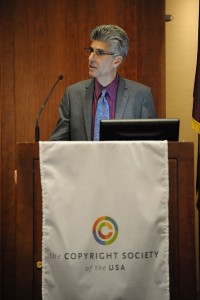Berkeley Law Professor Pamela Samuelson showcased the myriad functions of copyright’s merger doctrine, gleaned from her study of more than 100 such cases, while giving the Copyright Society of the USA’s 45th Annual Donald C. Brace Memorial Lecture co-sponsored by the Law School’s IP Institute, which is directed by Professor Hugh C. Hansen.
Merger, while rarely written about, has appeared in an increasing number of court cases in recent years, said Samuelson, who read 114 related cases this summer to form the basis for an upcoming paper on the subject.
“I am trying to crystallize what the role merger should play is and make crisper what the case law should do,” said Samuelson, a copyright law pioneer with three decades experience and a MacArthur Fellowship to her credit. The doctrine has produced some “amazing” developments over the past three decades, she added.
Before introducing Samuelson, Eric Schwartz, president of The Copyright Society of the USA, described merger to the audience as the gray area between protectable works and unprotectable ideas. With her research as her base, Samuelson, the director of Berkeley Center for Law & Technology, brought the issue into focus during her speech.

Samuelson explained that merger includes four basic types: idea/expression, fact/expression, law/expression, and function/expression. The doctrine’s myriad functions, particularly its impact on present-day copyright law, interests Samuelson most, she told the audience during her speech titled “Reconceptualizing Copyright’s Merger Doctrine.” For instance, it enables competition and promotes efficient design.
“You want to let the next person express their jeweled bee, if they want,” she said, referring to the Herbert Rosenthal Jewelry Corp. v. Kalpakian case involving two jewelers who produced pins in the shape of a bee.
Other merger cases she studied included the size of a vodka bottle, mathematical symbols, and the contents of maps. The most common instance was in software cases.
In many cases, the court says to avoid needless variation when something is a “basic building block of knowledge.”
“Think about it: If every mathematician had to use different symbols, that would make mathematics completely whacked,” Samuelson said, suggesting that allowing standardization of mathematical expressions is something “we all can agree upon.”
The Copyright Society of the USA, the largest copyright-focused organization in the United States, hosted the November 2 event.

